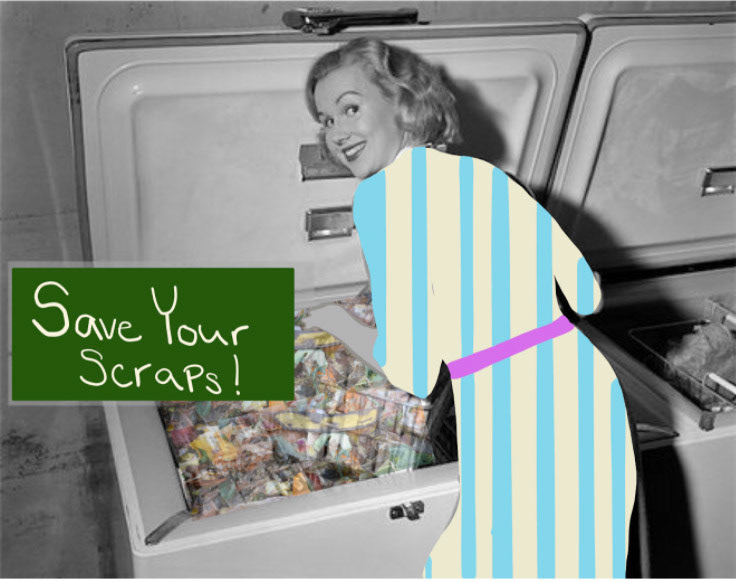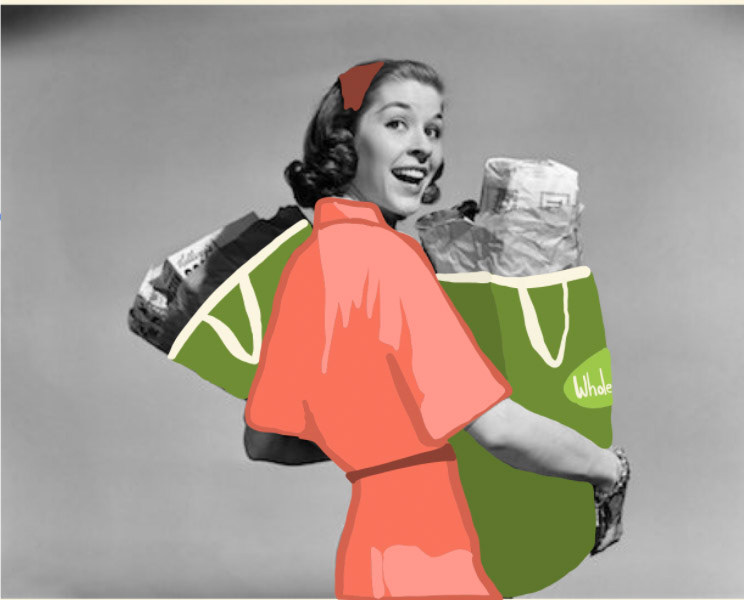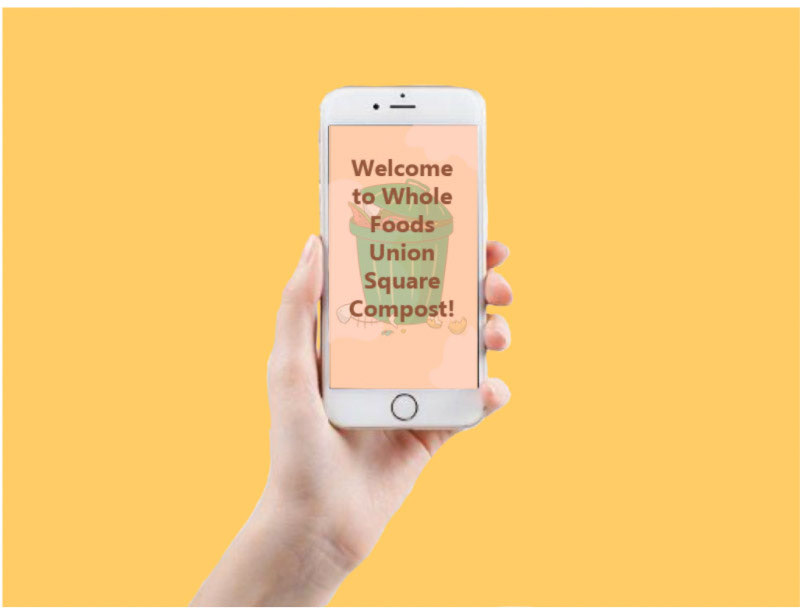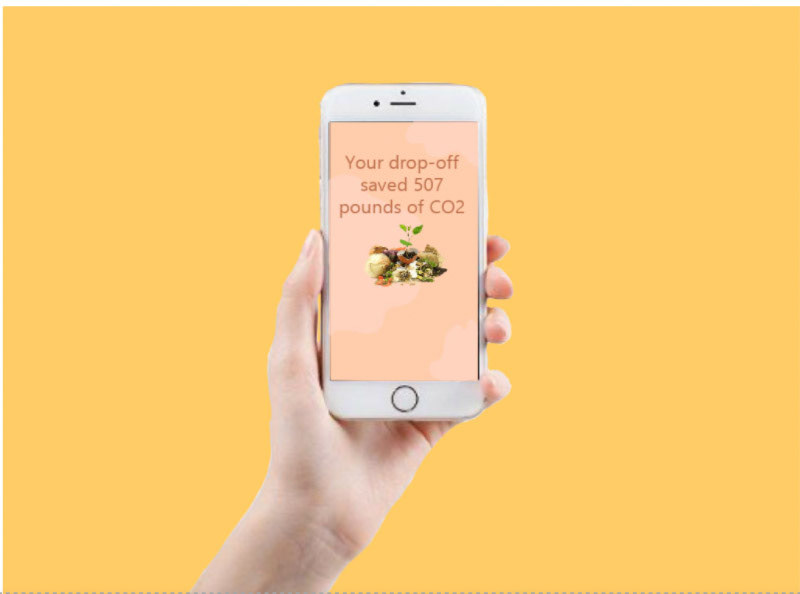Awareness and Visioning:
Food waste is a major global issue and is considerably worse in the United States. Thirty to forty percent of food supply in the U.S. gets thrown away and goes to landfills (Cooper 2020). Food waste in landfills produces higher levels of greenhouse gases because the organic materials decompose anaerobically and due to the lack of oxygen. This becomes methane instead of carbon dioxide. Methane is a much more potent greenhouse gas, so the phenomenon contributes more to climate change than if the material was used otherwise. Unfortunately, there will always be some food waste from households, but society needs to use this waste as a resource. It is truly a resource, not waste, because it can be used as source materials. Envisioning the future of food waste, we would like to see a future in which no food gets wasted and thrown in landfills. All food scraps should be reused or repurposed whether that is through compost, biogas, or animal feed. To accomplish this the waste must be collected. Our project aims to make the disposal of one’s food waste accessible to all socioeconomic levels, races, ethnicities, and abilities. We would also like to incorporate renewable energy into our system possibly using solar power and electric transport vehicles. Our system will also efficientize routes and use local facilities to decrease transportation needs. Some power dynamics that will have to be addressed by this project are the city, land, and communities. Getting approval for land use could hypothetically cause some friction between the community and government. Other power dynamics to consider would be between the sanitation department and the companies that produce the biogas and/or fertilizer. Overall, our project will utilize stakeholders from the community, the government, and the private sector to create a more sustainable future in which food is not wasted.
Composting for Convenience, was inspired by Sweden and Japan's sustainability efforts. In Sweden, grocery stores have machines that collect plastic bottles in return for compensation. Our system follows this model, but with food waste rather than plastic. In Japan, people must pay to dispose of their food waste. Our machines would be the same infrastructure as the Japanese model, but with similar programming of the Swedish recycling system.
Future Vision Article: Walmart, Kroger, Target and Other Major Supermarkets Implement Food Waste Program Nationwide
With about one third of all food in the U.S. going to waste, we are finally seeing major food distributors taking charge and offering new programs that solve the issues at hand(Cooper 2020). Many of us know that the U.S, as a whole has been a big player in carbon emissions when it comes to our changing climate. In 2023, we saw a Whole Foods and Amazon Fresh roll out a new program working with the U.S. government and local sanitation departments to offer easier compost drop offs for shoppers. In 2023, this program was offered at Whole Foods starting out nearest populated parks like Union Square & Bryant Park locations in Manhattan. After a year of a promising amount of participants, the program grew to all locations nationwide. Because of this success, other companies are now noticing the overwhelming use of this program, companies like Walmart are now doing the same. How was Whole Foods, a leader in this program so successful? In 2021, they pulled together a team to design this system with the goal to grow accessibility of local composting, grow their financial status, and deliver higher numbers of foot traffic. When the program was rolled out in 2023, shoppers at Whole Foods could drop off their compost before making their weekly grocery shopping at Whole Foods. Once the food was dropped off, the customer would scan their app, the compost machine would weigh their contributions and generate the amount of energy & carbon the individual just saved. The customer would then go on to seeing how their contribution saved them money each week by composting and shopping for food at Whole Foods. The ease of this service attracted more customers to shop at Whole Foods, as it not only saved them money, but allowed for incentives to easily play their societal role in reversing the damage done so far to the environment. In 2025, when Walmart’s stock saw a dip, they realized the consumer market wanted an ethical change in their shopping experience with them. When asked about their role in the Green New Deal, Dan Smith, C.F.O. of Walmart stated, “We have looked at the success of Whole Foods and how they used this new system to deliver all around beneficial goals in climate change to the green new deal. We are already working with AOC’s teams to deliver a similar system in Walmart’s nationwide.” By now, the consumer has shifted to more online shopping since the pandemic in 2020, thus retailers were already hit with in-store shopping experiences. Whole Foods was able to lead the way in not only a more ethical and sustainable approach to in-person shopping, but a successful model for incentivizing their experience. Major supermarkets are already speculating a rise in the economy again and a 50% dip of the U.S.’s carbon emissions by the end of the fiscal year with this new program.
Baseline mapping:
Our key elements for this project address time, rituals, assumptions, and money. Firstly, we remove the pain point of time. By locating the composting collection at the grocery store, we combined these activities for convenience. It only takes one trip to get your groceries and dispose of food waste. Due to the fact that grocery shopping is done weekly and sometimes more frequently, it provides the perfect timeline to eliminate smell. The combining of activities also removes barriers when it comes to rituals. It is challenging to create new habits, but our system builds on the existing habit of grocery shopping and bringing a reusable bag. The only additional routine that is being created is placing one's food waste in the collection tote rather than the garbage can. We want to change the narrative around food waste. Currently, it is considered gross, smelly, expensive, and time consuming. To further motivate people, we used sustainability principles to remove barriers and connotations from composting. The tote is specifically designed to reduce smell and mess. The removable lining makes disposing of one's food waste as simple as taking out the trash. As everyone is already familiarized with taking out the trash or recycling, it also normalizes saving one's food scraps. The collection tote is also designed to reduce smells as it is airtight. The bag can also be used as a grocery bag which is convenient, specifically with the normalization of plastic bans. Financially, Whole Foods is noted as an upscale grocery option to many and is perceived as non-accessible as a whole. We plan to fight this narrative and make our system more attractive to all with monetary incentives which grow the consumer base and provide a tangible reason to compost rather than relying on the fear of climate change. There are incentives such as savings on next grocery visits and monetary rewards in account. If our food waste system is able to successfully provide these financial benefits, then the act of composting will provide greater outreach and solutions on providing healthier food options to those of lower income.
Our project solely focuses on household food waste because on average, each American household wastes 31% of the food they purchase (Sharkey). This is incredibly problematic and is due to poor planning. Within the scheme of food waste, household food waste is entirely preventable and should not be going to the landfill. Collection is a very feasible task as it is already done nationally for trash and recycling; there is no reason that food waste should not be collected. Our stakeholders go beyond Whole Foods as a company, we anticipate cross collaboration with the NYC sanitation department, local compost sites, and local gardens.This relationship will enable less transportation and therefore fewer carbon emissions for compost pick-up and distribution.
Overall the system was designed by thinking of the customer service journeys. By doing this, we were able to deliver more realistic possible outcomes of what a system like this could provide for the users and Whole Foods as a company. We outlined our stakeholders: Whole Foods, the direct employees, the consumer, the community around Union Square, NYC sanitation, local compost companies, local gardens, and local soil manufactures. In doing so, we know that our project will be detailed to show how our system is beneficial in all markets economically, socially, ethically, and environmentally. In terms of our system being truly circular, there is still some room to grow within the materiality of the infrastructure. Most food waste storage containers and vending machines are made out of metal and or plastic. This is the aspect in which we identify some sustainability issues as food waste collection will be done on foot or public transportation, food waste drop off will be done using a fleet of electric or biogas trucks, and the deliberate use of local facilities.
Our key obstacle going forward into the 2020s is the creation of partnerships with grocery stores. Though we predict that grocery stores will be on board, especially when we can demonstrate increased customer traffic and satisfaction. Consumers are already demanding more from the retailers they choose to purchase from and Convenient Compost provides a tangible way in which people can challenge grocery stores to be better. As the mindsets of the public changes, more grocery stores will partner with Convenient Compost to better serve their needs, their customers needs, and environmental necessities.
Phase C: Creative solutions
To solve the problem of household food waste in New York City, we redesigned the current composting system to increase participation, be accessible, reduce time demands, improve convenience, and decrease the amount of food going in landfills. To accomplish this, we focussed on the Union Square area as a case study. The current composting system in Union Square and the greater New York City area is run by GrowNYC and the Sanitation Department. GrowNYC has compost collection areas at the farmers market in Union Square four days a week and is run mostly by volunteers. This collection location collects about 380 to 800 gallons of food waste a day and only has about 330 participants weekly. This is inadequate for a city of millions.
Our system, Composting for Convenience, enables compost collection in grocery stores. Motivated by incentives, customers drop off their food waste during their weekly trip to the grocery store with the help of our machines, app, and collection tote. The machines are manufactured using repurposed metals for durability. The machines are the same design as the Japanese models, but have software similar to that of Sweden’s plastic recycling system. To the right see an example of the Japanese collection machine. Our system uses the same model, but with an additional feature of a QR code scanner.
The app tracks the amount of food waste in weight deposited during each trip. This enables consumers to reflect on their waste in an effort to reduce it. This figure is also displayed as the amount of carbon dioxide emissions prevented by composting food waste rather than it going to a landfill. This plays on the sustainability principle of motivating by hope rather than fear. By showing customers they are helping, it transforms connotations around wasting food from a guilt ridden activity to the idea that one can positively impact the world by disposing of their waste properly. The app also allows people to set goals to encourage food waste reduction. To motivate people to compost further, our system features a social media function. This feature is similar to Venmo in which one can see the amount of carbon emissions your friends are diverting. This will add to the spirit of competition and social pressure. Customers also receive their incentives via the app.
Incentives are an integral part of our system. Currently, there are no tangible motivators to compost. The idea of climate change alone is not enough for behavior change. Compost for Convenience pays people to compost using the funds generated from selling the composted food waste. One can choose between money or credits towards Whole Foods purchases. The conversion rate would have a disparity to encourage people to shop at Whole Foods more, making the partnership mutually beneficial. Money would be available to be transferred to bank accounts, venmo, or Paypal.
Another aspect of our system is the food collection tote. The bag has an interchangeable liner that one disposes of when one deposits their food waste. This feature enables the rebranding of food waste as gross to something that is clean and tame. It also efficientize the system and creates fewer pain points for the grocery store to implement our system. It also doubles as a reusable grocery bag to limit the amount of items one has to bring. Though we acknowledge that this is designing for obsolescence, we feel that the benefits outweigh the costs. We did not specifically decide on a material for the bag as we believe more in depth research and experimentation on their specific carbon footprints would be necessary. We are considering various regenerative fabrics such as kombucha leather, soft bioplastics, algae plastics, and fruit peel leather. To reduce odors at home, store the tote in the freezer or refrigerator. To guide inexperienced composters, our system has the following guidelines about what can and cannot be composted. Materials that can be composted are: fruit & vegetable scraps, non-greasy food scraps (rice, pasta, bread, grains, cereal), coffee grounds & filters, tea bags, egg shells & nuts, cut flowers & houseplants, soiled brown paper products, potting soil. Materials that are not accepted: meat, fish, bones, dairy, fat, oil, greasy food scraps, animal waste, charcoal, coconuts, insect-infested plants, plastics, twist ties, rubber bands, or receipts.
From a technical standpoint, the following steps detail the consumers journey through the system:
1. Using the bag provided, collect food waste throughout the week following the usage guidelines.
2. When going to the grocery store, bring your food waste.
3. Enter the grocery store and log into the compost interface using the personalized QR code on the app.
4. Deposit food waste in disposable bag.
5. On the app, see the amount of carbon dioxide emissions prevented and amount of food wasted by weight. Share with friends!
6. See recommendations for foods to buy that are in season, recommended seasonal recipes, and coupons for Whole Foods.
7. Receive compensation for food waste deposit.
8. Replace bag liner.
9. Grocery shop.



Phase D: Deciding on priorities
The App:




